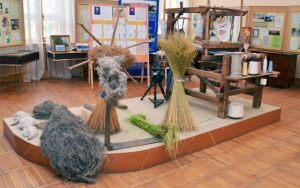
There is an unusual museum in the city of Kostroma on Tereshkova Street. Here, in a single, harmonious whole, two seemingly incompatible things are connected – flax and birch bark. This museum was built and created by Natalia Pavlovna Zabavina, a native of the city of Kostroma, Russia, in 2005. Since then, the museum has taken its rightful place among the most visited places by tourists visiting Kostroma. Here are 6 things you should know about the unique museum.
1. About Flax and Birch Bark
Flax is a sprout of Russian culture, from which, from ancient times, flax fiber, called “northern silk”, is used to produce fabrics and products for household and industrial purposes. These are clothes, home decoration, tarpaulins, fire hoses, protective clothing and soft containers. The basis for the best carpets and linoleum, two-thread for mittens, and canvas for artists are made from it. For many years, flax fiber has been one of the dominant Russian export products. Russia has the world’s largest flax raw material base and processing industry. More than a million hectares of land used to be allocated for flax crops. For many centuries, flax dressed and fed people. And if they say that bread is the head of everything, then it will be fair to say that flax is the soul of everything. Flax has always been a special culture in Russia. It fed, healed, and warmed people physically and mentally.
Each nation inhabiting Russia has developed a long and distinctive tradition of manufacturing household items from local natural materials. Some products have survived to present days without changes, others in an improved form. Surviving items easily entered the modern interior; and now, thanks to their beauty, expediency and high artistic qualities, they are not only elements of everyday life, but also works of traditional folk art. There are a great many names of birch bark itself, especially products in Russia. These names reflect both local features where they arose, and the identity, the influence of different Russian peoples on each other.
2. The Flax Hall
A tour of the museum begins with a hall of flax, where, listening to the bewitching speech of the guide, visitors will see with their own eyes the process of turning linen straw into peasant shirts. The spindle is spinning merrily, and a linen thread is pulled from the tow into the skilled hands of the craftswoman. The factory production of linen products is not deprived of attention either – at the expositions there are samples, both the beginning of the last century, and modern ones.
In this hall you can see products made of linen that was the main material from which clothes were sewed at that time. Linen fabric, varying in quality and texture, was used in different ways. The canvas and ussinka went to men’s and women’s shirts, scraps, towels. For outerwear, coarse cloth was used. There were other names of linen fabrics – partin, thinchina. The basis of the women’s costume was a linen shirt, over which on holidays a rich shirt was worn, decorated on the hem and sleeves with multi-colored braid with magical protective patterns. The women’s costume was complemented by a headdress – a crown or a dressing-gown, and a whole set of head, neck, chest, wrist jewelry.
3. The Birch Bark Hall
The characters of Russian fairy tales, made using the technique of weaving from birch bark, primarily attract the attention of visitors in the next hall of the museum. The guide’s story begins with a description of the traditions of manufacturing ancient birch bark products – pistons, shovels, pestles, bast baskets, collected in ethnographic expeditions in the Kostroma region.
Here, in the hall, you can see a lot of objects from birch bark. Some of them can be made right in the forest such as ladles and spoons. Making others – tueses, baskets, sets – requires knowledge of suture material, types of seams and joints. Even more complicated is the manufacture of tueses (beetroot) – birch bark vessels from a whole, filmed in the form of a tube of a section of birch bark, the so-called knotter. Tuesa and objects made from a piece of birch bark are almost always decorated with embossing, carving, painting, applique, which gives them additional grace and expressiveness. A special place among birch bark products, due to the peculiar method of their manufacture, is woven products. They are distinguished by an amazing wealth of shapes and sizes — from small salt shakers to huge purses (pestle) for carrying loads, from elegant vases and caskets to shoes and children’s toys.
4. Master Class
What could be more interesting than making your own birch bark souvenir? At the master class, everyone will learn the basics of working with birch bark and take away with them a commemorative sign with the symbols of the city of Kostroma. Another master class offers weaving and manufacturing of amulets.
5. The Souvenirs
Each visitor can purchase a souvenir from birch bark or linen in the souvenir department. Here in a large assortment are presented tueses decorated with embossing and unique author’s painting, caskets, bread bins, toys, linen dolls, amulets and much more. Many of the items on display here are made in the workshop of the museum.
6. Exhibition and Shop
The whole hall is reserved in the museum for the exhibition and sale of modern linen products. Here is everything that today’s “linen” Kostroma is rich in: tablecloths and napkins, bed linen and towels, knitted and sewn women’s, men’s and children’s clothes, traditional folk shirts, dresses and sundresses.
When approaching the museum, you will instantly notice the fabulous small tower surrounded by green lawns, bright flower beds, a trickle, bizarrely curved bridges, that will delight the visitors. Don’t miss the 6 things mentioned above when you visit Kostroma.
